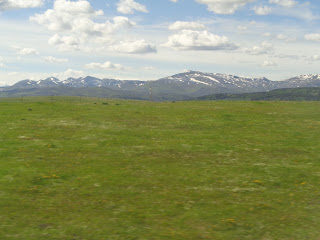Day 29 and we were back on the tracks again. This time
headed for St Paul, Minnesota, a twenty-four hour trip. The journey took us
through Glacier National Park via the Marias Pass, a route through the Rockies which was
originally sought by Lewis and Clark, but finally discovered by John Stevens in
1889 with the help of a Blackfoot Indian Guide.
We crossed the Continental Divide, the point at which rivers
either flow east to the Atlantic or west to the Pacific. At this point the pass
is 5,213 feet above sea level making it the lowest pass between Canada and New
Mexico. At the summit of the pass there is a monument to President Theodore Roosevelt in memory of his efforts to preserve America's natural resources, a subject which became dear to his heart after spending time in North Dakota.
From the park the train crosses Blackfeet Indian Reservation
and the land becomes considerably flatter with the mountains receding into the
distance.
The further we traveled the more isolated the landscape became.
 |
| more horses than people |
Often the only structures of any size were grain elevators,
seemingly in the middle of nowhere, but obviously a focus point for the nearby
farms.
When the settlers first came to Montana they were given 300
acres of land free on the understanding that they farmed it for five years and
put up a homestead. The idea was that they would be self-sufficient but 300
acres proved not to be big enough. Many of the settlers failed and moved on after
selling their land to more successful settlers thereby beginning the
consolidation of the land into larger ranches. The original homesteads were
abandoned and the ruins can still be seen today dotted around the farms.
Eight and a half hours later we eventually crossed into
North Dakota and there was a dramatic change in scenery.
In this area of the world it stays light until about ten
o’clock at night in June so we were able to see the many oil wells that dot the
landscape along the train route. Oil was discovered in North Dakota in the
1950’s and, with the improvement in oil retrieving technology including
fracking, is now oil rich.
We had a chance to talk to a guy who had moved to North Dakota to work in the oil industry after being made redundant elsewhere, and a couple who had lived all their lives in the town of Williston where there has been a huge increase in population in the last four years due to the oil boom. The difference in attitudes towards the effects of the oil boom could not have been greater. The oil worker reckoned the locals' attitudes were determined by whether they were making money or not from mineral rights, whereas the couple focused on the social problems such as the housing shortage, which has made some of the small towns as expensive as major cities, and the increase in crime and prostitution.
We had a chance to talk to a guy who had moved to North Dakota to work in the oil industry after being made redundant elsewhere, and a couple who had lived all their lives in the town of Williston where there has been a huge increase in population in the last four years due to the oil boom. The difference in attitudes towards the effects of the oil boom could not have been greater. The oil worker reckoned the locals' attitudes were determined by whether they were making money or not from mineral rights, whereas the couple focused on the social problems such as the housing shortage, which has made some of the small towns as expensive as major cities, and the increase in crime and prostitution.
There were also
masses of what looked to be lakes, one after another, but which a dinner
companion told us were enormous potholes that had filled with water. Attempts
had been made to fill in some of the holes for agricultural purposes but not all had been successful which is probably just as well as they are important breeding grounds for wildfowl, especially ducks.
With most of our journey across North Dakota and into
Minnesota overnight, it was morning before we had another chance to view the
passing landscape. Still, with a daytime trip from St Paul to Chicago in our
future, we should have plenty of time to see Minnesota in the
daylight.










Great pictures that show the diverse terrain in that part of the country. My family's from ND and I grew up in MN, so know it well. You're certainly getting the full picture of the US on this trip!
ReplyDeleteSeeing the changes in scenery has been one of the most fascinating aspects of the trip - it certainly makes you realise how big the US is. So much variety and yet each type of terrain can take hours to traverse. My only regret is that taking photos through a train window doesn't capture the full beauty.
Delete